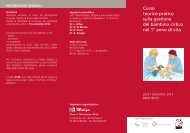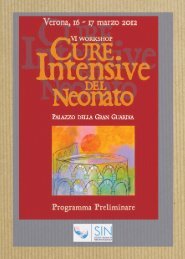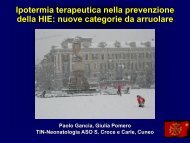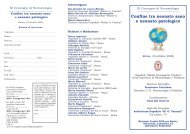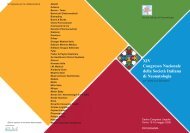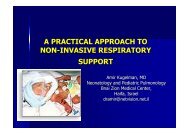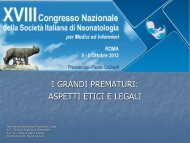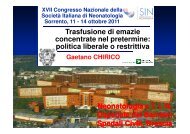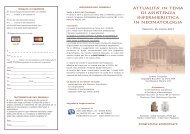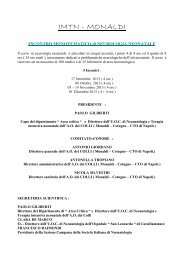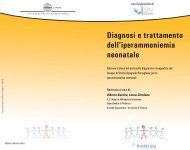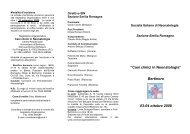Raccomandazioni per l'assistenza al neonato con encefalopatia
Raccomandazioni per l'assistenza al neonato con encefalopatia
Raccomandazioni per l'assistenza al neonato con encefalopatia
You also want an ePaper? Increase the reach of your titles
YUMPU automatically turns print PDFs into web optimized ePapers that Google loves.
<strong>Raccomandazioni</strong> <strong>per</strong> l’assistenza <strong>al</strong> <strong>neonato</strong> <strong>con</strong> encef<strong>al</strong>opatia ipossicoischemica<br />
possibile candidato <strong>al</strong> trattamento ipotermico<br />
���� ��������������<br />
�<br />
Incidenza<br />
L’encef<strong>al</strong>opatia ipossico-ischemica (EII) è una delle cause più comunemente ri<strong>con</strong>osciute di<br />
par<strong>al</strong>isi cerebr<strong>al</strong>e infantile (6-23%) (1). L’incidenza di asfissia intrapartum è di circa 3-4 <strong>per</strong><br />
1000 nati vivi (2); la incidenza di encef<strong>al</strong>opatia ipossico-ischemica, in assenza di <strong>al</strong>tre<br />
anom<strong>al</strong>ie pre-<strong>con</strong>cezion<strong>al</strong>i o antepartum, è di circa l’1.6 <strong>per</strong> 10000 nati vivi (3,4). L’EEI di<br />
grado moderato o severo è gravata da una mort<strong>al</strong>ità compresa tra il 10 e il 60%; tra i<br />
sopravvissuti il 25% sviluppa sequele neurologiche (5).<br />
Meccanismi patogenetici<br />
Il danno cerebr<strong>al</strong>e non è un evento unico bensì un processo evolutivo che inizia durante<br />
l’insulto ipossico-ischemico e che, nei casi più gravi e/o prolungati, <strong>con</strong>tinua in un <strong>per</strong>iodo<br />
successivo definito ‘fase di ri<strong>per</strong>fusione’. In fase acuta avviene la necrosi neuron<strong>al</strong>e diretta<br />
<strong>con</strong>seguente <strong>al</strong>l’ipossia cellulare <strong>con</strong> esaurimento del metabolismo energetico cellulare<br />
(insufficienza energetica primaria). Tuttavia molti neuroni non muoiono durante la prima fase<br />
dell’insulto ma, paradoss<strong>al</strong>mente, dopo la riossigenazione del <strong>neonato</strong>, da 6 a 100 ore dopo<br />
l’insulto ipossico-ischemico. Si tratta prev<strong>al</strong>entemente di morte neuron<strong>al</strong>e <strong>per</strong> apoptosi, un<br />
processo di distruzione cellulare che richiede energia e che può <strong>per</strong>durare anche <strong>per</strong> <strong>al</strong>cuni<br />
giorni (6).<br />
��������������������������������<br />
��������������������������������<br />
������� ��������� ��������������������������������<br />
������� ��������� ��������������������������������<br />
� �<br />
� �<br />
��������������������<br />
�����������<br />
����������<br />
���������<br />
����������<br />
������������������<br />
��������<br />
�������<br />
�����<br />
�������<br />
� �<br />
� �<br />
� ������������������������������<br />
��������������<br />
� �������������<br />
� ����������������������������<br />
������������������������<br />
������������������<br />
����������<br />
��������<br />



